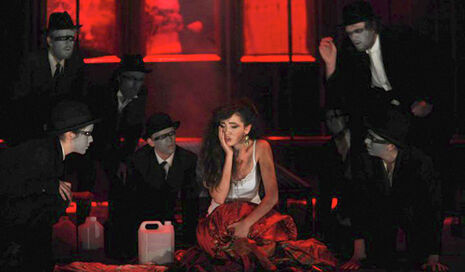Theatre: Agamemnon
Cambridge Arts Theatre

The Cambridge Greek Play is an extraordinary experience. There are very, very few professional productions in ancient Greek, and, until you see one, it is impossible to imagine what Greek theatre, with the all-singing all-dancing chorus, might have been like. This production must be seen if only to hear the subtle, and less subtle, rhythmic shifts from line to line. The chorus jump from passionate lyric to marching anapaests when Agamemnon enters with his army, then chant ominously as he goes in to his death, before breaking into hysterical iambics when they hear his screams.
All this was done with impressive competence by the student cast, some of whom had never read a word of Greek before. Particularly impressive was Sophie Crawford (Herald/Chorus), who kept up an amazingly fluent speech even as she struggled with her boots and huffed and puffed around the stage. The part of Cassandra (Phoebe Haines) was performed operatically: this perhaps disrupted the potential intimacy of her shared lyric with the chorus, but suitably marked her out as a lone prophetess caught up in a blind cycle of violence. The Watchman's famous opening speech was staged brilliantly on top of a scaffold in a filthy trench-coat, interrupted by mouthfuls of clingfilm-wrapped sandwich.
Such touches of stage-realism might surprise the modern audience. But moments of intense physicality are in fact characteristic of Greek drama: one might consider the quiver produced by Xerxes as the only relic of his enormous army in The Persians, or the urn of ashes in Sophocles' Electra. And so in Helen Eastman's production, props are brought onto the otherwise austere set with an almost religious reverence. Thus the chorus' sentimental re-enactment of Iphigineia's sacrifice, performed by cutting the heads off a bouquet of yellow roses, felt graphic rather than hammy. This production, promising to cast light on 'contemporary concerns' of war and political violence, also made much of a lament for the ashes of the Argive soldiers lost at Troy: for perhaps two minutes on end the chorus were occupied in carrying numbered petrol cans, representing the dead, onto the stage. These remained until the end of the play, casting a heavy shadow over the righteousness of Clytemnestra and Aegisthus, as well as that of Agamemnon.
Eastman's handling of the chorus, perhaps the most challenging as well as exciting feature of Greek tragedy, was more than competent. In an ancient Greek theatre they would have occupied the orchestra, as circular space in front of the scene, or stage, dancing and singing. Today's theatre, it is usually held, cannot tolerate such a disengagement between performers, even if it had the physical space to accommodate it; modern productions, therefore, often place the chorus at the back of the stage, enveloping the actors like a second audience. I once saw a performance of Heaney's The Burial at Thebes (an adaptation of Antigone) in which the actors rejoined the chorus for every ode. The danger of this solution is that the chorus no longer appears to be a constant intermediary presence; one may even forget they are there while the protagonists battle it out. In Eastman's Agamemnon on the other hand, the chorus occupied the same space as the actors, even during the episodic action, from their entrance until the end of the play. The stage was often very crowded as a result; chaos was averted by excellent choreography and what must have been tortuous rehearsals. This often gave the interesting impression that the Argive elders were being stage-managed by the protagonists themselves, particularly when Clytemnestra, reporting the news from Troy, placed a torch in each of their hands as she described the fire-signal spreading from peak to peak.
This Agamemnon avoids the pitfalls of staging Greek drama today, while never looking remotely stilted. It is imaginative without being pretentious or over-ambitious. What might easily have seemed incomprehensible and irrelevant is in fact a triumph.
 Comment / Plastic pubs: the problem with Cambridge alehouses 5 January 2026
Comment / Plastic pubs: the problem with Cambridge alehouses 5 January 2026 News / Cambridge businesses concerned infrastructure delays will hurt growth5 January 2026
News / Cambridge businesses concerned infrastructure delays will hurt growth5 January 2026 News / New movement ‘Cambridge is Chopped’ launched to fight against hate crime7 January 2026
News / New movement ‘Cambridge is Chopped’ launched to fight against hate crime7 January 2026 News / AstraZeneca sues for £32 million over faulty construction at Cambridge Campus31 December 2025
News / AstraZeneca sues for £32 million over faulty construction at Cambridge Campus31 December 2025 Interviews / You don’t need to peak at Cambridge, says Robin Harding31 December 2025
Interviews / You don’t need to peak at Cambridge, says Robin Harding31 December 2025









